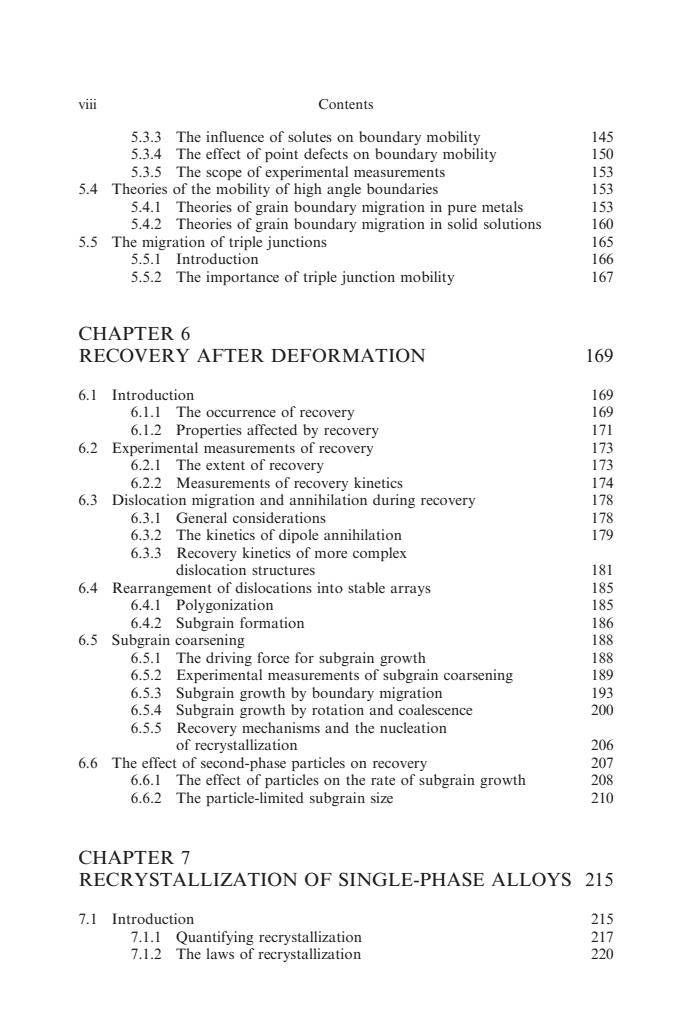
viii Contents 5.3.3 The influence of solutes on boundary mobility 145 5.3.4 The effect of point defects on boundary mobility 150 5.3.5 The scope of experimental measurements 153 5.4 Theories of the mobility of high angle boundaries 153 5.4.1 Theories of grain boundary migration in pure metals 153 5.4.2 Theories of grain boundary migration in solid solutions 160 5.5 The migration of triple junctions 165 5.5.1 Introduction 166 5.5.2 The importance of triple junction mobility 167 CHAPTER 6 RECOVERY AFTER DEFORMATION 169 6.1 Introduction 169 6.1.1 The occurrence of recovery 169 6.1.2 Properties affected by recovery 171 6.2 Experimental measurements of recovery 173 6.2.1 The extent of recovery 173 6.2.2 Measurements of recovery kinetics 174 6.3 Dislocation migration and annihilation during recovery 178 6.3.1 General considerations 178 6.3.2 The kinetics of dipole annihilation 179 6.3.3 Recovery kinetics of more complex dislocation structures 181 6.4 Rearrangement of dislocations into stable arrays 185 6.4.1 Polygonization 185 6.4.2 Subgrain formation 186 6.5 Subgrain coarsening 188 6.5.1 The driving force for subgrain growth 188 6.5.2 Experimental measurements of subgrain coarsening 189 6.5.3 Subgrain growth by boundary migration 193 6.5.4 Subgrain growth by rotation and coalescence 200 6.5.5 Recovery mechanisms and the nucleation of recrystallization 206 6.6 The effect of second-phase particles on recovery 207 6.6.1 The effect of particles on the rate of subgrain growth 208 6.6.2 The particle-limited subgrain size 210 CHAPTER 7 RECRYSTALLIZATION OF SINGLE-PHASE ALLOYS 215 7.1 Introduction 215 7.1.1 Quantifying recrystallization 217 7.1.2 The laws of recrystallization 220
5.3.3 The influence of solutes on boundary mobility 145 5.3.4 The effect of point defects on boundary mobility 150 5.3.5 The scope of experimental measurements 153 5.4 Theories of the mobility of high angle boundaries 153 5.4.1 Theories of grain boundary migration in pure metals 153 5.4.2 Theories of grain boundary migration in solid solutions 160 5.5 The migration of triple junctions 165 5.5.1 Introduction 166 5.5.2 The importance of triple junction mobility 167 CHAPTER 6 RECOVERY AFTER DEFORMATION 169 6.1 Introduction 169 6.1.1 The occurrence of recovery 169 6.1.2 Properties affected by recovery 171 6.2 Experimental measurements of recovery 173 6.2.1 The extent of recovery 173 6.2.2 Measurements of recovery kinetics 174 6.3 Dislocation migration and annihilation during recovery 178 6.3.1 General considerations 178 6.3.2 The kinetics of dipole annihilation 179 6.3.3 Recovery kinetics of more complex dislocation structures 181 6.4 Rearrangement of dislocations into stable arrays 185 6.4.1 Polygonization 185 6.4.2 Subgrain formation 186 6.5 Subgrain coarsening 188 6.5.1 The driving force for subgrain growth 188 6.5.2 Experimental measurements of subgrain coarsening 189 6.5.3 Subgrain growth by boundary migration 193 6.5.4 Subgrain growth by rotation and coalescence 200 6.5.5 Recovery mechanisms and the nucleation of recrystallization 206 6.6 The effect of second-phase particles on recovery 207 6.6.1 The effect of particles on the rate of subgrain growth 208 6.6.2 The particle-limited subgrain size 210 CHAPTER 7 RECRYSTALLIZATION OF SINGLE-PHASE ALLOYS 215 7.1 Introduction 215 7.1.1 Quantifying recrystallization 217 7.1.2 The laws of recrystallization 220 viii Contents
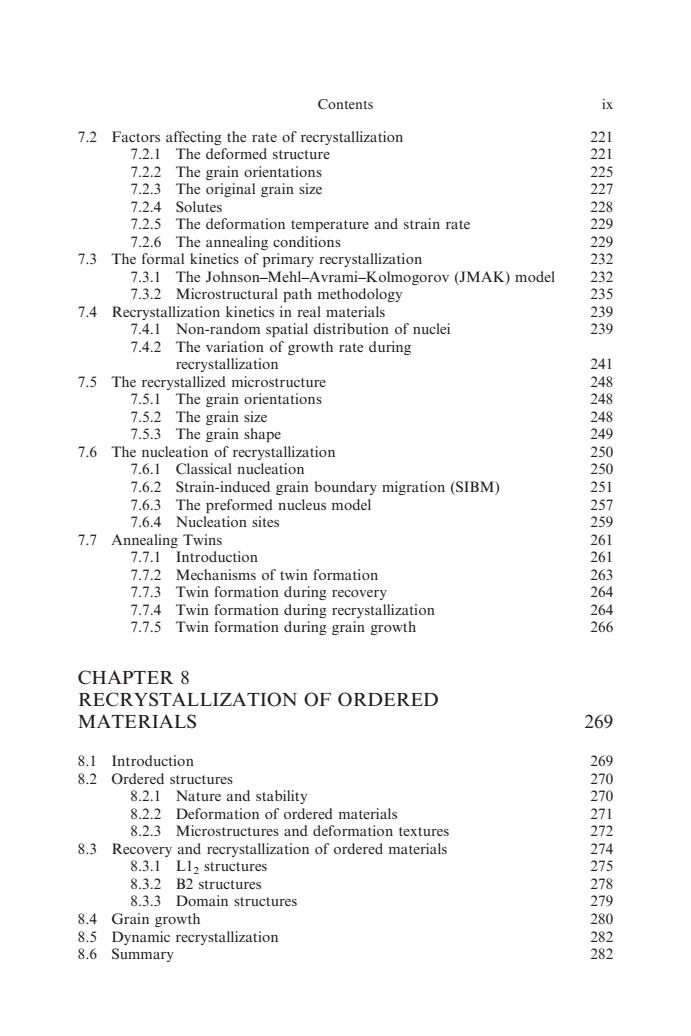
Contents 7.2 Factors affecting the rate of recrystallization 221 7.2.1 The deformed structure 221 7.2.2 The grain orientations 225 7.2.3 The original grain size 227 7.2.4 Solutes 228 7.2.5 The deformation temperature and strain rate 229 7.2.6 The annealing conditions 229 7.3 The formal kinetics of primary recrystallization 232 7.3.1 The Johnson-Mehl-Avrami-Kolmogorov (JMAK)model 232 7.3.2 Microstructural path methodology 235 7.4 Recrystallization kinetics in real materials 239 7.4.1 Non-random spatial distribution of nuclei 239 7.4.2 The variation of growth rate during recrystallization 241 7.5 The recrystallized microstructure 248 7.5.1 The grain orientations 248 7.5.2 The grain size 248 7.5.3 The grain shape 249 7.6 The nucleation of recrystallization 250 7.6.1 Classical nucleation 250 7.6.2 Strain-induced grain boundary migration(SIBM) 251 7.6.3 The preformed nucleus model 257 7.6.4 Nucleation sites 259 7.7 Annealing Twins 261 7.7.1 Introduction 261 7.7.2 Mechanisms of twin formation 263 7.7.3 Twin formation during recovery 264 7.7.4 Twin formation during recrystallization 264 7.7.5 Twin formation during grain growth 266 CHAPTER 8 RECRYSTALLIZATION OF ORDERED MATERIALS 269 8.1 Introduction 269 8.2 Ordered structures 270 8.2.1 Nature and stability 270 8.2.2 Deformation of ordered materials 271 8.2.3 Microstructures and deformation textures 272 8.3 Recovery and recrystallization of ordered materials 274 8.3.1 L12 structures 275 8.3.2 B2 structures 278 8.3.3 Domain structures 279 8.4 Grain growth 280 8.5 Dynamic recrystallization 282 8.6 Summary 282
7.2 Factors affecting the rate of recrystallization 221 7.2.1 The deformed structure 221 7.2.2 The grain orientations 225 7.2.3 The original grain size 227 7.2.4 Solutes 228 7.2.5 The deformation temperature and strain rate 229 7.2.6 The annealing conditions 229 7.3 The formal kinetics of primary recrystallization 232 7.3.1 The Johnson–Mehl–Avrami–Kolmogorov (JMAK) model 232 7.3.2 Microstructural path methodology 235 7.4 Recrystallization kinetics in real materials 239 7.4.1 Non-random spatial distribution of nuclei 239 7.4.2 The variation of growth rate during recrystallization 241 7.5 The recrystallized microstructure 248 7.5.1 The grain orientations 248 7.5.2 The grain size 248 7.5.3 The grain shape 249 7.6 The nucleation of recrystallization 250 7.6.1 Classical nucleation 250 7.6.2 Strain-induced grain boundary migration (SIBM) 251 7.6.3 The preformed nucleus model 257 7.6.4 Nucleation sites 259 7.7 Annealing Twins 261 7.7.1 Introduction 261 7.7.2 Mechanisms of twin formation 263 7.7.3 Twin formation during recovery 264 7.7.4 Twin formation during recrystallization 264 7.7.5 Twin formation during grain growth 266 CHAPTER 8 RECRYSTALLIZATION OF ORDERED MATERIALS 269 8.1 Introduction 269 8.2 Ordered structures 270 8.2.1 Nature and stability 270 8.2.2 Deformation of ordered materials 271 8.2.3 Microstructures and deformation textures 272 8.3 Recovery and recrystallization of ordered materials 274 8.3.1 L12 structures 275 8.3.2 B2 structures 278 8.3.3 Domain structures 279 8.4 Grain growth 280 8.5 Dynamic recrystallization 282 8.6 Summary 282 Contents ix
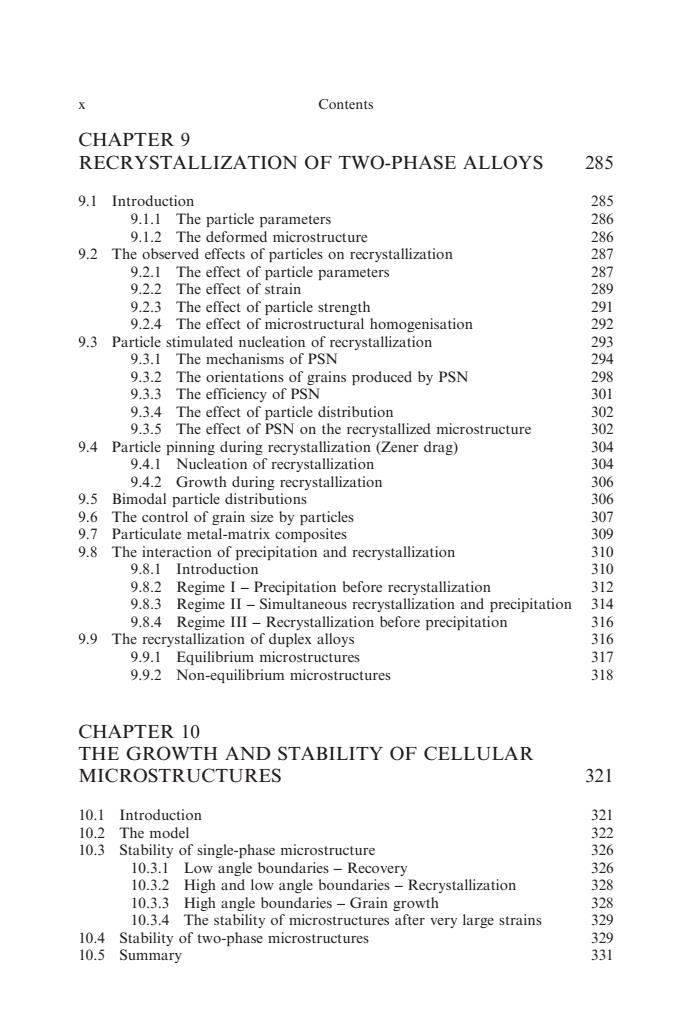
Contents CHAPTER 9 RECRYSTALLIZATION OF TWO-PHASE ALLOYS 285 9.1 Introduction 285 9.1.1 The particle parameters 286 9.1.2 The deformed microstructure 286 9.2 The observed effects of particles on recrystallization 287 9.2.1 The effect of particle parameters 287 9.2.2 The effect of strain 289 9.2.3 The effect of particle strength 291 9.2.4 The effect of microstructural homogenisation 292 9.3 Particle stimulated nucleation of recrystallization 293 9.3.1 The mechanisms of PSN 294 9.3.2 The orientations of grains produced by PSN 298 9.3.3 The efficiency of PSN 301 9.3.4 The effect of particle distribution 302 9.3.5 The effect of PSN on the recrystallized microstructure 302 9.4 Particle pinning during recrystallization(Zener drag) 304 9.4.1 Nucleation of recrystallization 304 9.4.2 Growth during recrystallization 306 9.5 Bimodal particle distributions 306 9.6 The control of grain size by particles 307 9.7 Particulate metal-matrix composites 309 9.8 The interaction of precipitation and recrystallization 310 9.8.1 Introduction 310 9.8.2 Regime I-Precipitation before recrystallization 312 9.8.3 Regime II-Simultaneous recrystallization and precipitation 314 9.8.4 Regime III-Recrystallization before precipitation 316 9.9 The recrystallization of duplex alloys 316 9.9.1 Equilibrium microstructures 317 9.9.2 Non-equilibrium microstructures 318 CHAPTER 10 THE GROWTH AND STABILITY OF CELLULAR MICROSTRUCTURES 321 10.1 Introduction 321 10.2 The model 322 10.3 Stability of single-phase microstructure 326 10.3.1 Low angle boundaries-Recovery 326 10.3.2 High and low angle boundaries-Recrystallization 328 10.3.3 High angle boundaries-Grain growth 328 10.3.4 The stability of microstructures after very large strains 329 10.4 Stability of two-phase microstructures 329 10.5 Summary 331
CHAPTER 9 RECRYSTALLIZATION OF TWO-PHASE ALLOYS 285 9.1 Introduction 285 9.1.1 The particle parameters 286 9.1.2 The deformed microstructure 286 9.2 The observed effects of particles on recrystallization 287 9.2.1 The effect of particle parameters 287 9.2.2 The effect of strain 289 9.2.3 The effect of particle strength 291 9.2.4 The effect of microstructural homogenisation 292 9.3 Particle stimulated nucleation of recrystallization 293 9.3.1 The mechanisms of PSN 294 9.3.2 The orientations of grains produced by PSN 298 9.3.3 The efficiency of PSN 301 9.3.4 The effect of particle distribution 302 9.3.5 The effect of PSN on the recrystallized microstructure 302 9.4 Particle pinning during recrystallization (Zener drag) 304 9.4.1 Nucleation of recrystallization 304 9.4.2 Growth during recrystallization 306 9.5 Bimodal particle distributions 306 9.6 The control of grain size by particles 307 9.7 Particulate metal-matrix composites 309 9.8 The interaction of precipitation and recrystallization 310 9.8.1 Introduction 310 9.8.2 Regime I – Precipitation before recrystallization 312 9.8.3 Regime II – Simultaneous recrystallization and precipitation 314 9.8.4 Regime III – Recrystallization before precipitation 316 9.9 The recrystallization of duplex alloys 316 9.9.1 Equilibrium microstructures 317 9.9.2 Non-equilibrium microstructures 318 CHAPTER 10 THE GROWTH AND STABILITY OF CELLULAR MICROSTRUCTURES 321 10.1 Introduction 321 10.2 The model 322 10.3 Stability of single-phase microstructure 326 10.3.1 Low angle boundaries – Recovery 326 10.3.2 High and low angle boundaries – Recrystallization 328 10.3.3 High angle boundaries – Grain growth 328 10.3.4 The stability of microstructures after very large strains 329 10.4 Stability of two-phase microstructures 329 10.5 Summary 331 x Contents
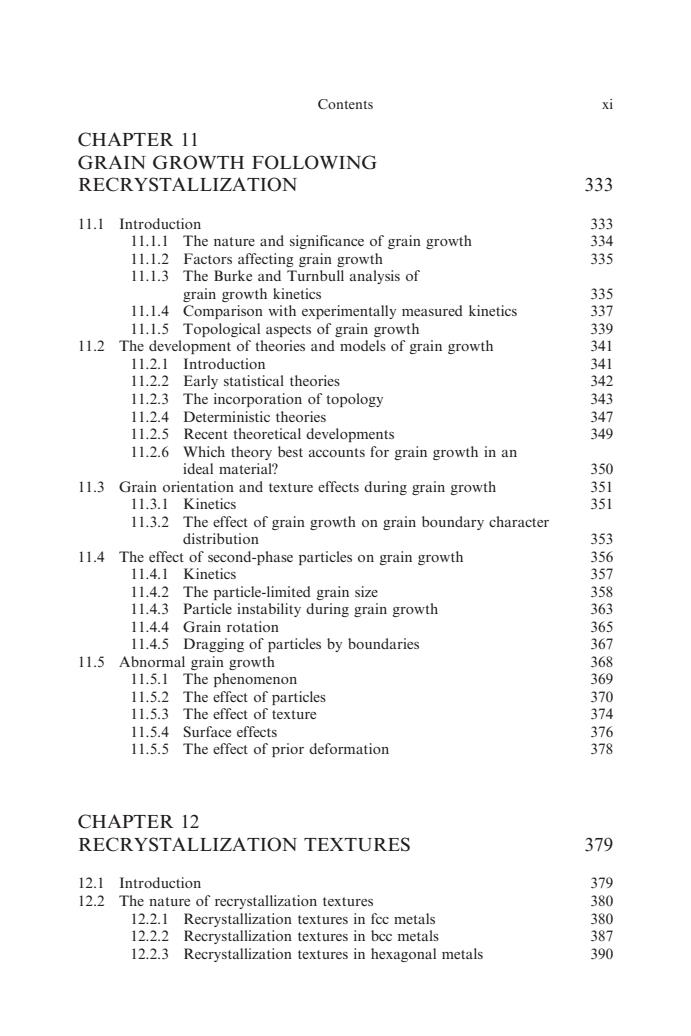
Contents xi CHAPTER 11 GRAIN GROWTH FOLLOWING RECRYSTALLIZATION 333 11.1 Introduction 333 11.1.1 The nature and significance of grain growth 334 11.1.2 Factors affecting grain growth 335 11.1.3 The Burke and Turnbull analysis of grain growth kinetics 335 11.1.4 Comparison with experimentally measured kinetics 337 11.1.5 Topological aspects of grain growth 339 11.2 The development of theories and models of grain growth 341 11.2.1 Introduction 341 11.2.2 Early statistical theories 342 11.2.3 The incorporation of topology 343 11.2.4 Deterministic theories 347 11.2.5 Recent theoretical developments 349 11.2.6 Which theory best accounts for grain growth in an ideal material? 350 11.3 Grain orientation and texture effects during grain growth 351 11.3.1 Kinetics 351 11.3.2 The effect of grain growth on grain boundary character distribution 353 11.4 The effect of second-phase particles on grain growth 356 11.4.1 Kinetics 357 11.4.2 The particle-limited grain size 358 11.4.3 Particle instability during grain growth 363 11.4.4 Grain rotation 365 11.4.5 Dragging of particles by boundaries 367 11.5 Abnormal grain growth 368 11.5.1 The phenomenon 369 11.5.2 The effect of particles 370 11.5.3 The effect of texture 374 11.5.4 Surface effects 376 11.5.5 The effect of prior deformation 378 CHAPTER 12 RECRYSTALLIZATION TEXTURES 379 12.1 Introduction 379 12.2 The nature of recrystallization textures 380 12.2.1 Recrystallization textures in fcc metals 380 12.2.2 Recrystallization textures in bcc metals 387 12.2.3 Recrystallization textures in hexagonal metals 390
CHAPTER 11 GRAIN GROWTH FOLLOWING RECRYSTALLIZATION 333 11.1 Introduction 333 11.1.1 The nature and significance of grain growth 334 11.1.2 Factors affecting grain growth 335 11.1.3 The Burke and Turnbull analysis of grain growth kinetics 335 11.1.4 Comparison with experimentally measured kinetics 337 11.1.5 Topological aspects of grain growth 339 11.2 The development of theories and models of grain growth 341 11.2.1 Introduction 341 11.2.2 Early statistical theories 342 11.2.3 The incorporation of topology 343 11.2.4 Deterministic theories 347 11.2.5 Recent theoretical developments 349 11.2.6 Which theory best accounts for grain growth in an ideal material? 350 11.3 Grain orientation and texture effects during grain growth 351 11.3.1 Kinetics 351 11.3.2 The effect of grain growth on grain boundary character distribution 353 11.4 The effect of second-phase particles on grain growth 356 11.4.1 Kinetics 357 11.4.2 The particle-limited grain size 358 11.4.3 Particle instability during grain growth 363 11.4.4 Grain rotation 365 11.4.5 Dragging of particles by boundaries 367 11.5 Abnormal grain growth 368 11.5.1 The phenomenon 369 11.5.2 The effect of particles 370 11.5.3 The effect of texture 374 11.5.4 Surface effects 376 11.5.5 The effect of prior deformation 378 CHAPTER 12 RECRYSTALLIZATION TEXTURES 379 12.1 Introduction 379 12.2 The nature of recrystallization textures 380 12.2.1 Recrystallization textures in fcc metals 380 12.2.2 Recrystallization textures in bcc metals 387 12.2.3 Recrystallization textures in hexagonal metals 390 Contents xi
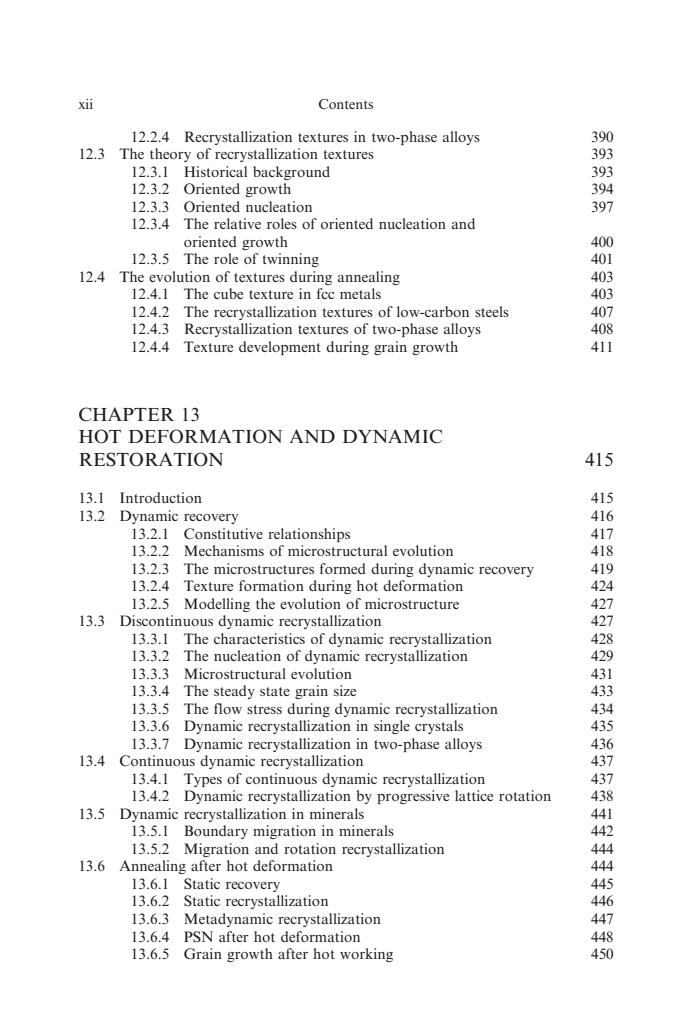
xii Contents 12.2.4 Recrystallization textures in two-phase alloys 390 12.3 The theory of recrystallization textures 393 12.3.1 Historical background 393 12.3.2 Oriented growth 394 12.3.3 Oriented nucleation 397 12.3.4 The relative roles of oriented nucleation and oriented growth 400 12.3.5 The role of twinning 401 12.4 The evolution of textures during annealing 403 12.4.1 The cube texture in fcc metals 403 12.4.2 The recrystallization textures of low-carbon steels 407 12.4.3 Recrystallization textures of two-phase alloys 408 12.4.4 Texture development during grain growth 411 CHAPTER 13 HOT DEFORMATION AND DYNAMIC RESTORATION 415 13.1 Introduction 415 13.2 Dynamic recovery 416 13.2.1 Constitutive relationships 417 13.2.2 Mechanisms of microstructural evolution 418 13.2.3 The microstructures formed during dynamic recovery 419 13.2.4 Texture formation during hot deformation 424 13.2.5 Modelling the evolution of microstructure 427 13.3 Discontinuous dynamic recrystallization 427 13.3.1 The characteristics of dynamic recrystallization 428 13.3.2 The nucleation of dynamic recrystallization 429 13.3.3 Microstructural evolution 431 13.3.4 The steady state grain size 433 13.3.5 The flow stress during dynamic recrystallization 434 13.3.6 Dynamic recrystallization in single crystals 435 13.3.7 Dynamic recrystallization in two-phase alloys 436 13.4 Continuous dynamic recrystallization 437 13.4.1 Types of continuous dynamic recrystallization 437 13.4.2 Dynamic recrystallization by progressive lattice rotation 438 13.5 Dynamic recrystallization in minerals 441 13.5.1 Boundary migration in minerals 442 13.5.2 Migration and rotation recrystallization 444 13.6 Annealing after hot deformation 444 13.6.1 Static recovery 445 13.6.2 Static recrystallization 446 13.6.3 Metadynamic recrystallization 447 13.6.4 PSN after hot deformation 448 13.6.5 Grain growth after hot working 450
12.2.4 Recrystallization textures in two-phase alloys 390 12.3 The theory of recrystallization textures 393 12.3.1 Historical background 393 12.3.2 Oriented growth 394 12.3.3 Oriented nucleation 397 12.3.4 The relative roles of oriented nucleation and oriented growth 400 12.3.5 The role of twinning 401 12.4 The evolution of textures during annealing 403 12.4.1 The cube texture in fcc metals 403 12.4.2 The recrystallization textures of low-carbon steels 407 12.4.3 Recrystallization textures of two-phase alloys 408 12.4.4 Texture development during grain growth 411 CHAPTER 13 HOT DEFORMATION AND DYNAMIC RESTORATION 415 13.1 Introduction 415 13.2 Dynamic recovery 416 13.2.1 Constitutive relationships 417 13.2.2 Mechanisms of microstructural evolution 418 13.2.3 The microstructures formed during dynamic recovery 419 13.2.4 Texture formation during hot deformation 424 13.2.5 Modelling the evolution of microstructure 427 13.3 Discontinuous dynamic recrystallization 427 13.3.1 The characteristics of dynamic recrystallization 428 13.3.2 The nucleation of dynamic recrystallization 429 13.3.3 Microstructural evolution 431 13.3.4 The steady state grain size 433 13.3.5 The flow stress during dynamic recrystallization 434 13.3.6 Dynamic recrystallization in single crystals 435 13.3.7 Dynamic recrystallization in two-phase alloys 436 13.4 Continuous dynamic recrystallization 437 13.4.1 Types of continuous dynamic recrystallization 437 13.4.2 Dynamic recrystallization by progressive lattice rotation 438 13.5 Dynamic recrystallization in minerals 441 13.5.1 Boundary migration in minerals 442 13.5.2 Migration and rotation recrystallization 444 13.6 Annealing after hot deformation 444 13.6.1 Static recovery 445 13.6.2 Static recrystallization 446 13.6.3 Metadynamic recrystallization 447 13.6.4 PSN after hot deformation 448 13.6.5 Grain growth after hot working 450 xii Contents